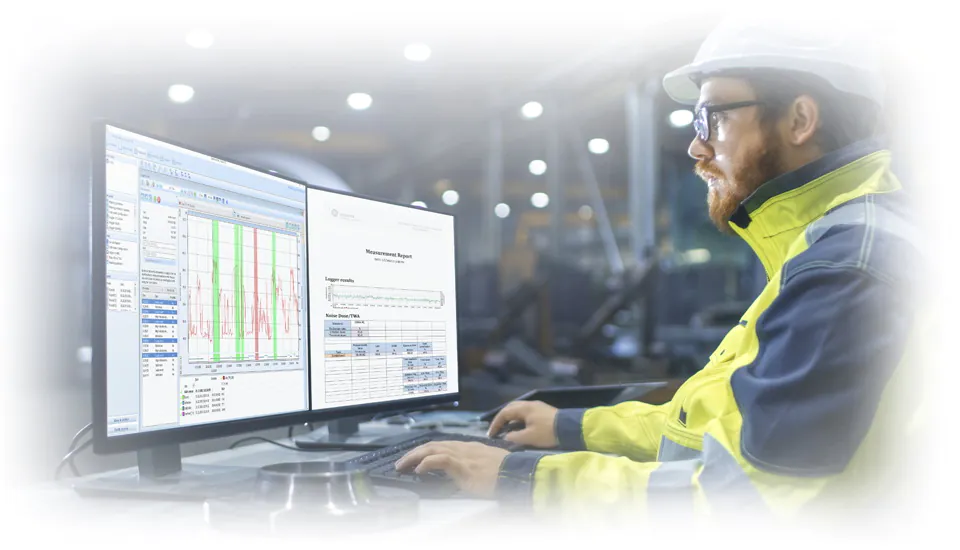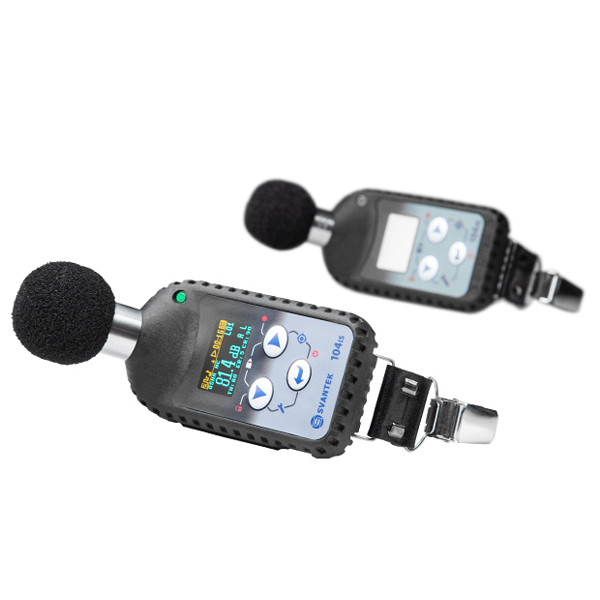
Noise can be a major issue in many industries, leading to long-term hearing damage and other health problems. To help workers protect their hearing, personal noise dosimeters have been developed to accurately measure the amount of noise exposure an individual is subjected to on the job. Here, we will explore the basics of personal noise dosimeters, including how they work, their benefits, and how they can be used in various industries to protect workers from hazardous noise levels. Whether you’re an occupational health and safety professional, a worker in a noisy environment, or just someone interested in protecting your hearing, we will provide valuable information and insights into the world of personal noise dosimeters.



A noise dosimeter is a device designed to measure an individual’s exposure to noise over a specific period of time. It’s a wearable instrument that’s placed on the body and can be used to evaluate noise exposure in various settings, such as the workplace, concerts, and other noisy environments. The noise dosimeter records the sound pressure level at the wearer’s ear and accumulates this information over time, providing a comprehensive measurement of total noise exposure. This information is then analyzed to assess the potential impact on hearing and determine if protective measures, such as hearing protection, need to be implemented to minimize the risk of hearing damage.
In the fields of Occupational Health and Industrial Safety, personal noise dosimeters are essential tools used to assess an individual’s exposure to noise during their workday. They provide valuable data that can be used to make informed decisions about implementing hearing protection and other solutions to reduce the time a person is exposed to high noise levels, ensuring the preservation of their hearing ability for years to come.
A personal noise dosimeter is a device that is designed to measure and monitor an individual’s exposure to noise over a certain period of time. It works by continuously measuring sound levels and integrating them into a single value, referred to as the sound dose. The sound dose represents the accumulated noise exposure an individual has experienced, taking into account fluctuations in sound levels and varying exposure durations. This provides a more accurate estimate of an individual’s noise exposure compared to traditional methods that only measure sound levels at a specific moment in time. Personal noise dosimeters are easy to use and can be used for a wide variety of applications, making it the preferred method for measuring noise exposure according to ISO 9612. Additionally, personal noise dosimeters can alert the user in real-time to the need for hearing protection based on their accumulated noise exposure.
The primary standard for noise dosimeters is ISO 9612. This standard outlines the specifications and requirements for personal noise dosimeters, including accuracy, frequency response, measurement range, and more. There are several other standards that a personal noise dosimeter can comply with, including OSHA standards, European Union directives, and various national and international regulations for noise exposure in the workplace. Additionally, some noise dosimeters are designed to meet specific industry standards, such as those for construction, manufacturing, and entertainment. To ensure compliance with the relevant standards, it is important to choose a noise dosimeter that is specifically designed to meet your needs and requirements.
When it comes to purchasing a noise dosimeter, it is important to consider several key factors to ensure that you get the right device for your needs. Some of the most important factors to consider include:
Accuracy: Ensure that the dosimeter you purchase is accurate and meets industry standards. Class 1 noise dosimeters are considered to be the most accurate.
Wearability: Consider the size, weight and ease of use of the dosimeter. Make sure that it is comfortable to wear for extended periods of time.
Features: Different dosimeters may have different features, such as real-time alerts, data storage, and reporting capabilities. Consider which features are important to you and ensure that the dosimeter you purchase has those features.
Price: Consider your budget and compare prices of different dosimeters to find one that fits your budget.
Reputation: Look for a well-established brand with a good reputation for quality and customer support.
IEC61252 standard compliance: Ensure that the dosimeter you purchase is compliant with the IEC61252 standard for noise dosimeters.
Integrated Sound Calibration: Determine if integrated sound calibration is necessary for your needs.
Microphone warranty: Consider the warranty offered on the microphone as it is a critical component of the dosimeter.
Use life expectation: Look for a dosimeter with a long use life expectation, to ensure that you get the most value for your investment.
At Svantek, take pride in being a top producer of noise and vibration monitoring equipment, consistently prioritizing quality and technical proficiency. Our team of skilled and creative design engineers works tirelessly to create a collection of noise dosimeters that are unmatched in their precision and excellence.
The SV 104A is a cutting-edge personal noise dosimeter designed to make noise measurement easier and more accurate. With its Bluetooth communication and smartphone app, the SV 104A is perfect for measuring noise levels in a variety of work environments and can be configured to meet the ISO 9612, OSHA, MSHA, and ACGIH standards. The dosimeter features a robust MEMS microphone with a lifetime warranty, a built-in tri-axial accelerometer for detecting vibrations and shocks, and an easy-to-read color OLED display. The SV 104A also includes a voice tagging feature, multiple virtual measurement profiles, and the ability to record audio events. With its automatic calibration and 48-hour operational time, the SV 104A is the perfect tool for any professional looking to measure noise levels accurately and efficiently.
The SV 104 is a cutting-edge personal noise dosimeter that packs a powerful punch in a compact design. Equipped with a virtually indestructible MEMS microphone and an inbuilt tri-axial accelerometer for vibration shock detection, the SV 104 is both technologically advanced and incredibly durable. The high-resolution color OLED screen adds to the user-friendly experience, making taking noise measurements a breeze. With features such as automatic calibration start, voice tagging, and real-time analysis options, the SV 104 is designed to provide accurate and reliable results. With a long operational time of over 40 hours and a rechargeable battery, the SV 104 is an affordable solution for your noise measurement needs.
The SV 104IS is an intrinsically safe personal noise dosimeter with advanced features such as real-time 1/1 octave band analysis and audio event recording. The device features a robust 1/2″ MEMS microphone with an autocalibration function and TEDS memory, a high contrast OLED screen, and a built-in tri-axial accelerometer for vibration shock detection. It has a measurement range of 60 dBA RMS to 140 dBA Peak and can be used with Svantek’s “Supervisor” software for data analysis and reporting. The device is compact, lightweight, and operates for up to 50 hours with a rechargeable battery. It meets ATEX and IECEx intrinsic safety standards, as well as IEC 61252 and ANSI S1.25 standards for personal noise dosimetry.
The new SV 104 BIS is equipped with the new MEMS microphone, which offers a measuring range from 53 dB Leq to 143 dB Peak. The list of addons includes new large 8 GB memory and fast data transmission with new completely docking stations. The device features a robust 1/2″ MEMS microphone with an autocalibration function and TEDS memory, a high contrast OLED screen, and a built-in tri-axial accelerometer for vibration shock detection
Among the unique features of the new model, the software is automatic noise dose calculation, sound pressure level logging, audio recording, octave band frequency analysis, and auto-calibration. The new ATEX dosimeter has an 8GB memory and fast data transfer via new docking stations. The new Bluetooth® interface enables previewing current results on a mobile app.
The SV102+ is a dual-channel acoustic dosimeter that offers advanced features for occupational health and safety noise monitoring. The device features a full-color OLED screen for easy readability and increased storage capability with a microSD card. The SV102+ allows for simultaneous 1/1 and 1/3 octave analysis, audio events recording, and dual channel measurement, giving a more accurate assessment of noise exposure. The device is low-powered and operates on just two AAA batteries, and is fully supported by the Supervisor software. Calibration is made easy with the TEDS technology and SV34 calibrator, ensuring correct calibration factors are used. The compact and lightweight design of the SV102+ makes it easy to operate and carry, making it a versatile and efficient tool for measuring noise exposure.
Using a noise dosimeter typically involves the following steps:
Preparation: Before using the noise dosimeter, make sure to read the manual, the standard followed in your region or country and familiarize yourself with the device’s features and controls. Charge the battery and insert the memory card if your model has one.
Calibration: Most noise dosimeters require regular calibration to ensure accurate readings. This can be done using a sound level calibrator or by performing an on-site calibration procedure.
Mounting: Attach the noise dosimeter to your body using the provided clip or another mounting device. Make sure the microphone is positioned close to your ear to accurately measure the sound levels you are exposed to.
Start measurement: Turn on the noise dosimeter and select the desired measurement profile. The device will start recording and integrating sound levels over time.
Real-time monitoring: Some noise dosimeters have real-time monitoring features that allow you to see the current sound levels and the accumulated dose in real time. This can be useful to determine when to use hearing protection.
Stop measurement: When you are finished with the measurement, turn off the device and remove it from your body.
Data analysis: Transfer the measurement data to your computer for analysis using the provided software or data transfer cable. The software will display the sound levels over time and the accumulated dose, which can be used to assess the risk of hearing damage.
It is important to follow the manufacturer’s instructions and guidelines when using a noise dosimeter to ensure accurate and reliable readings.
Calibrating a noise dosimeter is an important step in ensuring accurate noise measurements. It is recommended to have the calibration performed by a certified partner to guarantee the accuracy of the instrument. During the calibration process, the noise dosimeter is compared to a known standard and any necessary adjustments are made to the instrument to ensure that it is measuring sound levels correctly. The frequency response, microphone sensitivity, and linearity of the instrument are all checked during the calibration process. The calibration process should be performed regularly to ensure that the instrument continues to provide accurate measurements over time. Calibrating the instrument with a certified partner ensures that the instrument is calibrated to the appropriate standards and that all necessary procedures are followed to ensure accurate measurements.
Noise dosimeters are essential tools in the fields of Occupational Health and Safety for measuring an individual’s exposure to noise over a period of time. They work by continuously measuring sound levels, integrating them into a single value called the sound dose, and providing a more accurate estimate of an individual’s noise exposure compared to traditional methods. The primary standard for noise dosimeters is ISO 9612, with other standards including OSHA, EU directives, and national regulations. When choosing a noise dosimeter, factors such as accuracy, wearability, features, price, and reputation of the brand should be considered. Svantek offers a range of cutting-edge noise dosimeters, including the SV 104A, SV 104, SV 104IS, and SV102+. Using a noise dosimeter involves steps such as preparation, calibration, mounting, start measurement, real-time monitoring, stop measurement, and data analysis. Calibration is a crucial step in ensuring accurate noise measurements and should be performed regularly by a certified partner.
Tel +1 561-912-9809 / 561-9112-7201
E-mail [email protected]
6590 W Rogers Circle Suite# 11&12
Boca Raton – FL 33487
+1 561-912-9809 / +1 561-912-7201
[email protected]
6590 W Rogers Circle, Suite #11&12
Boca Raton, FL 33487